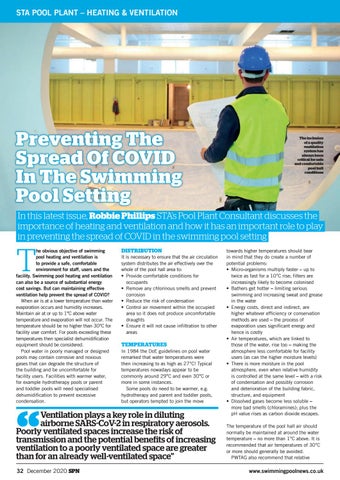STA POOL PLANT – HEATING & VENTILATION
Preventing The Spread Of COVID In The Swimming Pool Setting
The inclusion of a quality ventilation system has always been critical for safe and comfortable pool hall conditions
In this latest issue, Robbie Phillips STA’s Pool Plant Consultant discusses the importance of heating and ventilation and how it has an important role to play in preventing the spread of COVID in the swimming pool setting
T
he obvious objective of swimming pool heating and ventilation is to provide a safe, comfortable environment for staff, users and the facility. Swimming pool heating and ventilation can also be a source of substantial energy cost savings. But can maintaining effective ventilation help prevent the spread of COVID? When air is at a lower temperature than water evaporation occurs and humidity increases. Maintain air at or up to 1°C above water temperature and evaporation will not occur. The temperature should be no higher than 30°C for facility user comfort. For pools exceeding these temperatures then specialist dehumidification equipment should be considered. Pool water in poorly managed or designed pools may contain corrosive and noxious gases that can degrade the structure of the building and be uncomfortable for facility users. Facilities with warmer water, for example hydrotherapy pools or parent and toddler pools will need specialised dehumidification to prevent excessive condensation.
DISTRIBUTION It is necessary to ensure that the air circulation system distributes the air effectively over the whole of the pool hall area to: • Provide comfortable conditions for occupants • Remove any chlorinous smells and prevent corrosion • Reduce the risk of condensation • Control air movement within the occupied area so it does not produce uncomfortable draughts • Ensure it will not cause infiltration to other areas
TEMPERATURES In 1984 the DoE guidelines on pool water remarked that water temperatures were then increasing to as high as 27°C! Typical temperatures nowadays appear to be commonly around 29°C and even 30°C or more in some instances. Some pools do need to be warmer, e.g. hydrotherapy and parent and toddler pools, but operators tempted to join the move
Ventilation plays a key role in diluting airborne SARS-CoV-2 in respiratory aerosols. Poorly ventilated spaces increase the risk of transmission and the potential benefits of increasing ventilation to a poorly ventilated space are greater than for an already well-ventilated space” 32 December 2020 SPN 32-33_SPN_December_20_STA_Rev.indd 32
towards higher temperatures should bear in mind that they do create a number of potential problems: • Micro-organisms multiply faster – up to twice as fast for a 10°C rise; filters are increasingly likely to become colonised • Bathers get hotter – limiting serious swimming and increasing sweat and grease in the water • Energy costs, direct and indirect, are higher whatever efficiency or conservation methods are used – the process of evaporation uses significant energy and hence is costly • Air temperatures, which are linked to those of the water, rise too – making the atmosphere less comfortable for facility users (as can the higher moisture levels) • There is more moisture in the pool atmosphere, even when relative humidity is controlled at the same level – with a risk of condensation and possibly corrosion and deterioration of the building fabric, structure, and equipment • Dissolved gases become less soluble – more bad smells (chloramines); plus the pH value rises as carbon dioxide escapes. The temperature of the pool hall air should normally be maintained at around the water temperature – no more than 1°C above. It is recommended that air temperatures of 30°C or more should generally be avoided. PWTAG also recommend that relative
www.swimmingpoolnews.co.uk 11/01/2021 16:29
